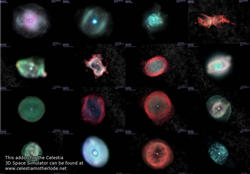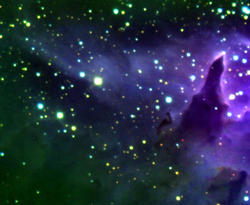Nebulae
Nebulae
| Planetary nebulae are shells of gas thrown out by some stars near the end of their lives. They are transient phenomenons, lasting between 30,000 and 100,000 years between formation and complete dissipation. It is likely that our own Sun will become a planetary nebula after exhausting its supply of nuclear fuel, about five billion years from now. Generally when observing planetary nebulae use the highest power your telescope can give. Also, an OIII filter is of great use for finding small planetaries that could easily be mistook for a star. To identify a planetary nebula with such a filter you must repeat observations with and without the filter, and the nebula will |
Because planetary nebulae have a reasonably high surface brightness, it is possible to observe most of them from moderately light-polluted locations, with telescopes of at least 150-mm.
Planetary nebulae are spectacular objects in the sky which emit a rich spectrum of recombination lines and collisional-excited lines. Modern space observations have found that planetary nebulae emit strong in almost every part of the electromagnetic spectrum, making them one of the most interesting astrophysical objects to study. Planetary nebulae not only serve as valuable laboratories for atomic processes, they can also be used as standard candles to calibrate the distance scale of the universe, as well as being used as tracers of dark matter in the galactic environment.
Although 95% of stars pass through this stage of evolution before they become white dwarfs, the origin of the planetary nebulae phenomenon was poorly understood as late as the 1970s. It is now believed the planetary nebulae are formed from the remnants of the circumstellar envelopes ejected by their progenitors asymptotic giant branch stars, and are compressed and accelerated into their present ring-like structure by the interacting winds process (Kwok, Purton, & FitzGerald 1978, ApJ, 219, L125).
At the University of Calgary, we have been active in both theoretical and observational studies of planetary nebulae. Models have been constructed to simulate the spectral energy distribution of planetary nebulae by combining dust radiation transfer, ionization models, and stellar evolution models. Over 150 compact PN have been mapped with the VLA at very high (0.4 to 0.1 arc sec) angular resolutions. Many nebulae of high surface brightness (which are therefore likely to be young PN) have been identified. The morphologies seen in these radio images are similar in character and relative frequencies to the optical morphologies, which are sampling a group of much larger and older PN. We seek to understand the general characteristics of the PN morphology and why the shaping of PN appears to happen early in their evolution. We would also like to determine whether the morphology evolves as the nebula ages, despite the similarity of the morphologies of the young PNs in the radio sample to those of the older PN for which optical images are available. The morphologies of PN give us information about the mass loss on the AGB and in the PN phase, for the PN appear to be shaped by the interaction of these two stellar winds.
Proto-planetary nebulae (PPN) are objects in transition between the asymptotic giant branch and planetary nebulae phases. IRAS sources with low (~100-200 K) color temperatures are selected as candidates for identification with mid-infrared photometry. Near-infrared and optical photometry are carried out to determine their spectral energy distributions. PPN often show a double-peak distribution, which is the result of the light from the central star emerging from the dissipating circumstellar dust envelope. Optical spectroscopy is then used to determine the spectral type of the central star. PPN are expected to have spectral types intermediate between AGB stars and planetary nebulae, ranging from G to late A. Many PPN candidates are found to be of luminosity class I, suggesting that the have low surface gravities and extended atmospheres. Molecular spectroscopy at the mm or submm wavelengths are also used to study the chemical composition of their circumstellar envelopes.
A number of proto-planetary nebulae discovered by us have been imaged by the Hubble Space Telescope



